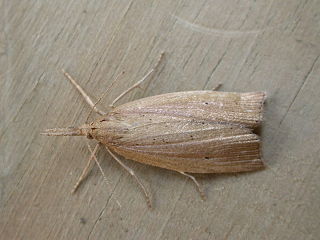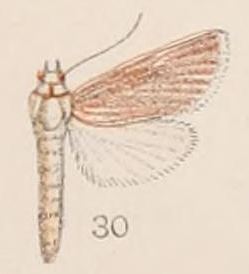
The Sesiidae or clearwing moths are a diurnal moth family in the order Lepidoptera known for their Batesian mimicry in both appearance and behaviour of various Hymenoptera.

Crambinae is a large subfamily of the lepidopteran family Crambidae, the crambid snout moths. It currently includes over 1,800 species worldwide. The larvae are root feeders or stem borers, mostly on grasses. A few species are pests of sod grasses, maize, sugar cane, rice, and other Poaceae. The monophyly of this group is supported by the structure of the tympanal organs and the phallus attached medially to the juxta, as well as genetic analyses.

Asura is a genus of moths in the subfamily Arctiinae, and subtribe Nudariina erected by Francis Walker in 1854.

The genus Crambus includes around 155 species of moths in the family Crambidae, distributed globally. The adult stages are called crambid snout moths, while the larvae of Crambus and the related genus Herpetogramma are the sod webworms, which can damage grasses.

Lyclene is a genus of lichen moths of the family Erebidae, subfamily Arctiinae. The genus was erected by Frederic Moore in 1860.

Miltochrista is a genus of moths of the family Erebidae, subfamily Arctiinae. The genus was erected by Jacob Hübner in 1819.

Ancylolomia is a genus of moths of the family Crambidae described by Jacob Hübner in 1825.

Chilo is a genus of moths of the family Crambidae. Some of these moths are called borers.
Hoploscopa is a genus of snout moths in the subfamily Hoploscopinae of the family Crambidae. The genus was described by Edward Meyrick in 1886, with Hoploscopa astrapias as type species.

Patissa is a genus of moths of the family Crambidae erected by Frederic Moore in 1886.

Prionapteryx is a genus of moths of the family Crambidae.

Bryolymnia is a genus of moths of the family Noctuidae erected by George Hampson in 1908.

Euplexia is a genus of moths of the family Noctuidae described by Stephens in 1829.
Prasinopyra is a genus of moths of the family Noctuidae. The genus was erected by George Hampson in 1914.

Bryolymnia semifascia, the half-banded bryolymnia, is a moth of the family Noctuidae. The species was first described by John Bernhardt Smith in 1900. It is found in the US from northern Colorado and southern Utah southward to south-eastern Arizona and south-central New Mexico.
Asura semifascia is a moth of the family Erebidae. It is found in Sri Lanka and Myanmar.
Hoploscopa diffusa is a moth in the family Crambidae, first described by George Hampson in 1919. It is found in New Guinea, where it has been recorded from the D'Entrecasteaux Islands.
Hoploscopa triangulifera is a moth in the family Crambidae. It was described by George Hampson in 1919.
Hoploscopa ocellata is a moth in the family Crambidae. It was described by George Hampson in 1919. It is found on the Moluccas in Indonesia.
Hoploscopa metacrossa is a moth in the family Crambidae. It was described by George Hampson in 1917. It is found on New Guinea.








